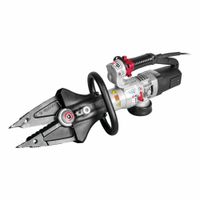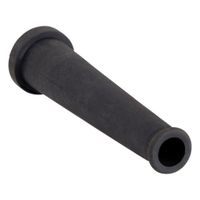Call +(254) 703 030 000 / 751 483 999 / 721 704 777
- Home
- Tools
- Power Tools
- Power Shears Nibblers
.....Read More
Frequently Asked Questions
What are the main differences between power shears and nibblers?
Power shears and nibblers are both tools used for cutting sheet metal, but they operate differently and are suited for different applications.
1. **Cutting Mechanism**:
- **Power Shears**: Use a scissor-like action with two blades, one fixed and one moving, to cut through metal. The shearing action results in a clean, straight cut.
- **Nibblers**: Use a punch-and-die mechanism to remove small bits of metal, creating a path through the sheet. This results in a more jagged edge compared to shears.
2. **Cutting Speed**:
- **Power Shears**: Generally faster due to the continuous cutting action, making them suitable for long, straight cuts.
- **Nibblers**: Slower as they remove small sections of metal at a time, but they can handle more intricate shapes.
3. **Cutting Precision**:
- **Power Shears**: Provide cleaner, straighter cuts, ideal for applications requiring precision.
- **Nibblers**: Better for cutting curves and complex shapes, though the edge may require additional finishing.
4. **Material Waste**:
- **Power Shears**: Produce minimal waste, as the metal is cut rather than removed.
- **Nibblers**: Generate more waste in the form of small metal chips.
5. **Applications**:
- **Power Shears**: Best for straight cuts in sheet metal, roofing, and siding.
- **Nibblers**: Suitable for cutting irregular shapes, curves, and tight corners.
6. **Ease of Use**:
- **Power Shears**: Easier to control for straight cuts.
- **Nibblers**: Require more skill to guide along complex patterns.
7. **Thickness Capacity**:
- **Power Shears**: Can handle thicker materials but may struggle with tight curves.
- **Nibblers**: Better for thinner materials and intricate designs.
Which tool is better for cutting curves in sheet metal, shears or nibblers?
For cutting curves in sheet metal, nibblers are generally better suited than shears. Nibblers are designed to make intricate cuts and can handle tight curves with ease. They work by punching out small bits of metal, allowing for greater maneuverability and precision when following curved lines. This makes them ideal for tasks that require detailed and complex shapes.
Shears, on the other hand, are more suited for straight cuts or gentle curves. They work by slicing through the metal, which can be challenging when trying to navigate tight or intricate curves. While shears can be used for curves, they often require more effort and may not provide the same level of precision as nibblers.
Additionally, nibblers tend to produce cleaner edges with less distortion, which is crucial when working on projects that demand high accuracy and a smooth finish. Shears can sometimes leave jagged edges or cause the metal to warp, especially when cutting curves.
In summary, for cutting curves in sheet metal, nibblers offer better precision, ease of use, and cleaner results compared to shears.
How do I choose between a shear and a nibbler for my project?
To choose between a shear and a nibbler, consider the following factors:
1. **Material Type and Thickness**:
- **Shear**: Best for straight cuts in thin to medium gauge sheet metal. It slices through the material like scissors, making it ideal for softer metals.
- **Nibbler**: Suitable for thicker materials and can handle a variety of metals, including steel and aluminum. It removes small bits of metal, allowing for more intricate cuts.
2. **Cutting Precision and Complexity**:
- **Shear**: Provides clean, straight cuts but struggles with curves and intricate shapes.
- **Nibbler**: Excels at cutting complex shapes and curves due to its maneuverability.
3. **Edge Finish**:
- **Shear**: Produces a smooth edge, reducing the need for additional finishing.
- **Nibbler**: Leaves a rougher edge that may require deburring.
4. **Speed and Efficiency**:
- **Shear**: Faster for straight cuts, making it efficient for repetitive tasks.
- **Nibbler**: Slower due to its cutting method but more versatile for detailed work.
5. **Waste and Material Loss**:
- **Shear**: Minimal waste, as it slices through the material.
- **Nibbler**: Generates more waste due to the nibbling process.
6. **Noise and Vibration**:
- **Shear**: Generally quieter with less vibration.
- **Nibbler**: Can be noisier and produce more vibration.
7. **Budget and Tool Availability**:
- **Shear**: Often more affordable and widely available.
- **Nibbler**: May be more expensive but offers greater versatility.
8. **Project Requirements**:
- Consider the specific needs of your project, such as the type of cuts, material, and desired finish.
Choose a shear for straight, clean cuts in thinner materials and a nibbler for intricate, curved cuts in thicker materials.
What materials can power shears and nibblers cut?
Power shears and nibblers are versatile tools used for cutting various materials, primarily in metalworking and construction.
1. **Sheet Metal**: Both tools are highly effective in cutting sheet metal, including steel, aluminum, and stainless steel. They can handle different thicknesses, typically ranging from 18 to 14 gauge, depending on the tool's power and blade capacity.
2. **Aluminum**: Power shears and nibblers can cut through aluminum sheets and profiles, making them suitable for tasks in automotive and aerospace industries where aluminum is commonly used.
3. **Stainless Steel**: These tools can cut stainless steel sheets, though the thickness they can handle may be less than that of regular steel due to stainless steel's hardness.
4. **Copper**: Copper sheets and thin copper pipes can be cut using power shears and nibblers, useful in plumbing and electrical applications.
5. **Plastic**: Certain power shears are designed to cut through plastic materials, including PVC and acrylic sheets, often used in construction and signage.
6. **Fiberglass**: Some power shears can cut fiberglass sheets, which are used in various industrial applications.
7. **Wire Mesh**: Power shears can also cut through wire mesh and expanded metal, which are used in fencing and security applications.
8. **Rubber and Vinyl**: Specialized shears can cut rubber and vinyl materials, useful in flooring and automotive industries.
The choice between power shears and nibblers depends on the specific application. Power shears are ideal for straight cuts and long, continuous cuts, while nibblers are better for intricate shapes and curves. The material's thickness and hardness will also determine the appropriate tool and blade type.
Are power shears or nibblers more suitable for cutting corrugated panels?
Power shears are generally more suitable for cutting corrugated panels compared to nibblers. Power shears use a scissor-like action to cut through metal, providing clean, straight cuts with minimal distortion to the material. This makes them ideal for cutting along the ridges and valleys of corrugated panels, maintaining the integrity of the panel's shape. They are efficient for long, straight cuts and can handle thicker materials, which is often required for corrugated panels.
Nibblers, on the other hand, work by punching out small bits of metal, which can be advantageous for making intricate cuts or curves. However, this method can leave a rougher edge and produce more waste material in the form of metal chips. While nibblers are excellent for detailed work and can navigate tight corners, they may not be as effective for maintaining the straight, clean lines needed for large sections of corrugated panels.
In summary, for tasks that require long, straight cuts with minimal material distortion, power shears are the preferred choice. They offer speed, precision, and a cleaner finish, making them more suitable for the demands of cutting corrugated panels.
How do I maintain and sharpen power shears and nibblers?
To maintain and sharpen power shears and nibblers, follow these steps:
1. **Cleaning**: Regularly clean the tools after each use. Remove any metal shavings, dust, and debris using a brush or compressed air. This prevents buildup that can affect performance.
2. **Lubrication**: Apply a light machine oil to moving parts to reduce friction and wear. Focus on the blades, pivot points, and any other moving components. Wipe off excess oil to prevent attracting dust.
3. **Inspection**: Frequently inspect the blades and cutting edges for signs of wear or damage. Check for nicks, dullness, or misalignment. Also, ensure that all screws and bolts are tight.
4. **Sharpening**: For shears, use a sharpening stone or file to hone the blades. Maintain the original bevel angle, typically around 20-30 degrees. For nibblers, replace the punch and die if they become dull, as sharpening is not usually feasible.
5. **Alignment**: Ensure the blades are properly aligned. Misalignment can cause poor cutting performance and increased wear. Adjust the blade tension according to the manufacturer's specifications.
6. **Replacement**: Replace blades or cutting parts when they become too worn or damaged to sharpen effectively. Always use parts recommended by the manufacturer to ensure compatibility and performance.
7. **Storage**: Store the tools in a dry, clean environment. Use protective covers or cases to prevent damage and exposure to moisture.
8. **Safety Checks**: Regularly check the power cord and plug for any signs of damage. Ensure that all safety features, such as guards and switches, are functioning correctly.
By following these maintenance steps, you can extend the life of your power shears and nibblers, ensuring they remain sharp and efficient for cutting tasks.
What safety precautions should I take when using power shears and nibblers?
When using power shears and nibblers, prioritize safety by following these precautions:
1. **Personal Protective Equipment (PPE):** Wear safety goggles to protect your eyes from flying debris. Use ear protection to guard against noise. Wear gloves to protect your hands, but ensure they are tight-fitting to avoid entanglement. Use steel-toed boots to protect your feet from falling materials.
2. **Work Area Safety:** Ensure the work area is clean and well-lit. Remove any tripping hazards and ensure the floor is dry to prevent slips. Keep the area free of unnecessary personnel to avoid accidents.
3. **Tool Inspection:** Before use, inspect the power shears and nibblers for any damage or wear. Check the power cord for frays and ensure all guards and safety features are in place and functional.
4. **Proper Handling:** Always hold the tool with both hands for better control. Maintain a firm grip and ensure your hands are dry to prevent slipping. Keep fingers away from the cutting area.
5. **Correct Operation:** Follow the manufacturer’s instructions for operation. Do not force the tool; let it do the work. Use the correct blade or attachment for the material being cut. Avoid cutting materials that exceed the tool's capacity.
6. **Electrical Safety:** Ensure the tool is properly grounded. Use a Ground Fault Circuit Interrupter (GFCI) if working in damp conditions. Avoid using the tool in wet environments to prevent electric shock.
7. **Maintenance:** Regularly clean and maintain the tool according to the manufacturer’s guidelines. Replace worn or damaged parts immediately to ensure optimal performance and safety.
8. **Emergency Preparedness:** Be aware of the location of the emergency stop button or switch. Know the procedure for shutting down the tool quickly in case of an emergency.
By adhering to these precautions, you can minimize the risk of accidents and ensure a safer working environment when using power shears and nibblers.






